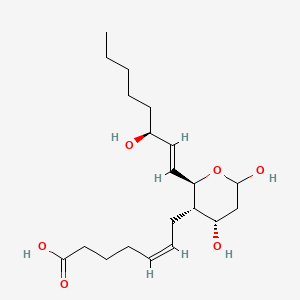Thromboxane b2
Thromboxane b2 is a lipid of Fatty Acyls (FA) class. Thromboxane b2 is associated with abnormalities such as endothelial dysfunction, Diabetes Mellitus, Non-Insulin-Dependent, Diabetes Mellitus, Ischemia and Thrombocytosis. The involved functions are known as Platelet Activation, Excretory function, Anabolism, Inflammation and mRNA Expression. Thromboxane b2 often locates in Endothelium, Hepatic and Microsomes, Liver. The associated genes with Thromboxane b2 are PTGS2 gene, prothrombin fragment 2 and CCL14 wt Allele.
Cross Reference
Introduction
To understand associated biological information of Thromboxane b2, we collected biological information of abnormalities, associated pathways, cellular/molecular locations, biological functions, related genes/proteins, lipids and common seen animal/experimental models with organized paragraphs from literatures.
What diseases are associated with Thromboxane b2?
Thromboxane b2 is suspected in endothelial dysfunction, Diabetes Mellitus, Non-Insulin-Dependent, Diabetes Mellitus, Ischemia, Thrombocytosis, Acute Coronary Syndrome and other diseases in descending order of the highest number of associated sentences.
Related references are mostly published in these journals:
| Disease | Cross reference | Weighted score | Related literature |
|---|
Possible diseases from mapped MeSH terms on references
We collected disease MeSH terms mapped to the references associated with Thromboxane b2
PubChem Associated disorders and diseases
What pathways are associated with Thromboxane b2
There are no associated biomedical information in the current reference collection.
PubChem Biomolecular Interactions and Pathways
Link to PubChem Biomolecular Interactions and PathwaysWhat cellular locations are associated with Thromboxane b2?
Visualization in cellular structure
Associated locations are in red color. Not associated locations are in black.
Related references are published most in these journals:
| Location | Cross reference | Weighted score | Related literatures |
|---|
What functions are associated with Thromboxane b2?
Related references are published most in these journals:
| Function | Cross reference | Weighted score | Related literatures |
|---|
What lipids are associated with Thromboxane b2?
There are no associated biomedical information in the current reference collection.
What genes are associated with Thromboxane b2?
Related references are published most in these journals:
| Gene | Cross reference | Weighted score | Related literatures |
|---|
What common seen animal models are associated with Thromboxane b2?
There are no associated biomedical information in the current reference collection.
NCBI Entrez Crosslinks
All references with Thromboxane b2
Download all related citations| Authors | Title | Published | Journal | PubMed Link |
|---|---|---|---|---|
| Tanaka H et al. | Leukotriene (LT)-receptor antagonist is more effective in asthmatic patients with a low baseline ratio of urinary LTE4 to 2,3-dinor-6-keto-prostaglandin (PG)F1alpha. | 1999 | Allergy | pmid:10380781 |
| Elissalde MH and Beier RC | Stimulation and release of prostaglandins and thromboxane from macrophages by cotton dust associated lipopolysaccharides. | 1990 | Am Ind Hyg Assoc J | pmid:2270833 |
| Andersson T et al. | Evaluation of the pharmacodynamics of acetylsalicylic acid 81 mg with or without esomeprazole 20 mg in healthy volunteers. | 2012 | Am J Cardiovasc Drugs | pmid:22631032 |
| Leese PT et al. | Valdecoxib does not impair platelet function. | 2002 | Am J Emerg Med | pmid:12098171 |
| Jung TT and Juhn SK | Prostaglandins in human cholesteatoma and granulation tissue. | 1988 | Am J Otol | pmid:3177602 |
| Mehta P et al. | Plasma concentrations of thromboxane and prostacyclin metabolites in patients with bone tumors. | 1985 | Am J Pediatr Hematol Oncol | pmid:2994511 |
| Natarajan G et al. | Chorioamnionitis and ontogeny of circulating prostaglandin and thromboxane in preterm infants. | 2008 | Am J Perinatol | pmid:18726836 |
| Brown HL et al. | Plasma and amniotic fluid prostacyclin and thromboxane in mild pregnancy-induced hypertension. | 1987 | Am J Perinatol | pmid:3566883 |
| Satterfield S et al. | Biochemical markers of compliance in the Physicians' Health Study. | 1990 Sep-Oct | Am J Prev Med | pmid:2268456 |
| Ingster LM and Feinleib M | Salicylate intake and cardiovascular disease: Ingster and Feinleib respond to Hu and Willett. | 1998 | Am J Public Health | pmid:9702172 |
| Cambria RA et al. | Thromboxane synthetase inhibition decreases polymorphonuclear leukocyte activation following hindlimb ischemia. | 1991 | Am Surg | pmid:1847027 |
| Smith EF and Lefer AM | Stabilization of cardiac lysosomal and cellular membranes in protection of ischemic myocardium due to coronary occlusion:efficacy of the nonsteroidal anti-inflammatory agent, naproxen. | 1981 | Am. Heart J. | pmid:7211667 |
| Buerke M et al. | Aspirin therapy: optimized platelet inhibition with different loading and maintenance doses. | 1995 | Am. Heart J. | pmid:7661062 |
| Cotter G et al. | Lack of aspirin effect: aspirin resistance or resistance to taking aspirin? | 2004 | Am. Heart J. | pmid:14760328 |
| O'Connor KM et al. | The effect of thromboxane inhibition on vulnerability to ventricular fibrillation in the acute and chronic feline infarction models. | 1989 | Am. Heart J. | pmid:2929400 |
| Neri Serneri GG et al. | Abnormal cardiocoronary thromboxane A2 production in patients with unstable angina. | 1985 | Am. Heart J. | pmid:3984828 |
| Roy L et al. | Lack of efficacy of nafazatrom, a novel anti-thrombotic compound, in patients with coronary artery disease. | 1985 | Am. Heart J. | pmid:3158183 |
| Yamada Y et al. | Possible mechanism of vascular reocclusion after initially successful thrombolysis with recombinant tissue-type plasminogen activator. | 1991 | Am. Heart J. | pmid:1903579 |
| FitzGerald GA et al. | Cigarette smoking and hemostatic function. | 1988 | Am. Heart J. | pmid:3276116 |
| Jouve R et al. | Thromboxane B2, 6-keto-PGF1 alpha, PGE2, PGF2 alpha, and PGA1 plasma levels in arteriosclerosis obliterans: relationship to clinical manifestations, risk factors, and arterial pathoanatomy. | 1984 | Am. Heart J. | pmid:6581715 |
